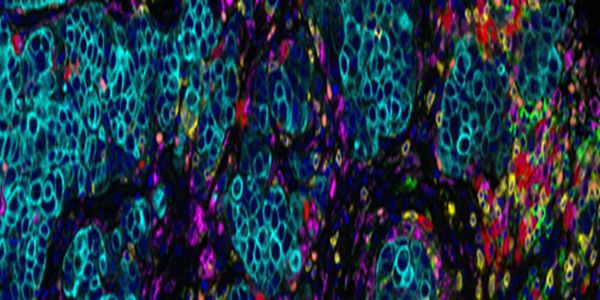Cellular Pathology
Cellular Pathology: Cellular pathology, also known as anatomical (or anatomic) pathology is the branch of pathology that involves the study of body organs and tissues (groups of cells). Cellular pathology is considered one of the diagnostic branches of medicine, along with radiology and other pathology specialties (e.g. microbiology, haematology, blood transfusion and biochemistry). Its roles include determining the cause of certain diseases and the effect(s) that they are having on the body, assisting with the choice of treatment that will be given, aiding in giving a prognosis and determining what may have caused a person's death.
-
MAR 21, 2019 | 7:00 AMDATE: March 21, 2019TIME: 7:00am PDT, 10:00am EDT The benefits of multiplex immunohistochemistry assays for tissue analysis are numerous. High-level multipl...The size and burden of mental illness should ideally prompt a strategy of preemption and early intervention. On the neuroscientific side, this leads to the question of brain mechanisms of ris...Speaker: Andreas Meyer-Lindenberg, MD, MSc, MBAPresented at: Neuroscience Virtual Event Series 2019
MAR 05, 2019 | 10:00 AM
DATE: March 5, 2019TIME: 10:00am PSTSingle cell analysis, starting with the earliest low parameter fluorescent experiments, helped define the major cell subsets of human ce...
FEB 07, 2019 | 8:00 AM
Date: February 7, 2019Time: 8:00am PST, 11:00am EST Modern microscopes are becoming increasingly complex instruments enabling registration of image sets far beyon...
NOV 15, 2018 | 10:00 AM
DATE: November 15, 2018TIME: 10:00am PT, 1:00pm ET Multiplex fluorescence immunohistochemistry offers a window into the biology of human disease, enabling the ana...
Speaker:
Traci DeGeer, BS, HT (ASCP) HTL, QIHC
, Alexander Klimowicz
Sponsored By: Leica Biosystems
As the most common female malignancy, breast cancer is the most likely reason that a woman will die of cancer around the world. Breast cancer mortality has dropped in the U.S. by 35% since 19...
Speaker:
Benjamin Anderson, MD
Lung cancer is the leading cause of cancer-related mortality worldwide. Large-scale sequencing studies have revealed the complex genomic landscape of NSCLC and genomic differences between lun...
Speaker:
Nicholas McGranahan, PhD
Two projects looking at novel approaches to targeting inflammatory breast cancer will be presented. Inflammatory breast cancer (IBC) is a unique, understudied, and most lethal subtype account...
Speaker:
Kevin Williams, PhD
The oncogenic transcription factor c-MYC (MYC) is deregulated, and often overexpressed, in more than 50% of cancers. MYC deregulation is associated with poor prognosis and aggressive disease,...
Speaker:
Jason De Melo, PhD
In the past two decades a small number of infrequently dividing cells have been proposed as the source of multi-drug resistance during cancer treatment. These cells identified by their expres...
Speaker:
Krastan Blagoev, PhD
PacBio Sequencing simultaneously provides long sequence reads, high consensus accuracy, minimal sequence bias, and methylation detection. I will highlight new advances and updates on applying...
Speaker:
Jonas Korlach, PhD
OCT 11, 2018 | 8:00 AM
DATE: October 11, 2018TIME: 8:00AM PDTSimultaneous quantitation of 6 or more biomarkers in intact tissue specimens holds the key to many questions concerning the biological basis o...
RNA sequencing unlocks the mysteries hidden in the transcriptome. Whether your goal is gene expression analysis, gene fusion analysis, SNP analysis or miRNA expression analysis, achieving hig...
Speaker:
Jonathan Shaffer, PhD, MBA
























